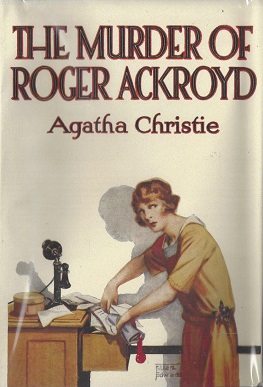The Murder of Roger Ackroyd was my Christie choice for this year as it is one I hadn't read before and is considered one of her finest. I can honestly say that I did not guess the killer until the last 30 pages of the book. I was shocked and surprised. I can't say anything more about the novel for fear of spoiling it, but I do think it is one of her best and every one should wait for a rainy day, grab a cup of tea, and read it in one sitting.
Although poison makes an appearance in The Murder of Roger Ackroyd, it isn't the star (that's the most I can say without giving the plot away). So why did I chose Deborah Blum's The Poisoner's Handbook: Murder and the Birth of Forensic Medicine in Jazz Age New York? For one, I really wanted to read this book. Secondly, time period wise it occurs about the same period of time. Ackroyd was published in 1926 and the Jazz Age occurred in the 1920s. But thirdly and most of all I wanted to read the two books in conjunction because of this quote, taken from Blum's epilogue to Poisoner's:
"...[I]n reality, I find poison killing among the most disturbing of all homicides.... They're closer to that lurking monster in the closet than some drug-impaired crazy with a gun."Blum recognizes that most poisoning cases are frightening because the murderer has planned to kill someone familiar and poison is the perfect way to go undetected. Although Blum's book does detail some instances of poisoning from unsafe working conditions, accidental deaths, unregulated products, and a rogue killer; most of the cases involve someone poisoning their spouse, family, friends, children, etc.... I think that this is what links the book to Christie; her murderers live among the victims. In other words, someone at the dinner table is a murderer and that in itself is horrifying.
While The Murder of Roger Ackroyd was entertaining and page-turning, I don't think I can say enough positives about Poisoner's Handbook. The book details the science behind poison and forensics, but it also offers a fascinating history of Charles Norris (medical examiner) and Alexander Gettler (toxicologist) and how the two men increased the accuracy of forensic science by repeated experiments and scholarly research, established procedures and a place of professionalism, and cleaned out corruption within the office. I also learned a great deal about the formation of the FDA, Prohibition, criminal organizations, and the dangerous life of Jazz Age New York (I never thought of what it would be like in NY with everyone driving and no standard driver's license or driving laws... ack!).
Blum really brought the science of toxicology to life; almost too much. At one point I was reading about an autopsy and there was a discussion of various tools used to saw into parts and I literally had tunnel vision. I thought I was going to black out! I was disgusted by what my imagination did to the description and at the same time in awe of the powerful writing.
History, mystery, true crime, and science fans thoroughly enjoy The Poisoner's Handbook and mystery fans are sure to be stumped -- at least for a bit -- by The Murder of Roger Ackroyd.
~~~~~~~~~~~~~~~~~~~~~~~~~~~~~~~~~~~~~~~~~~~~~~~~~~~~~~~~~~~~~~~~~~~~~~~~~
The Murder of Roger Ackroyd was read for the Truth in Fiction challenge and Vintage Mystery Reading Challenge.
The Poisoner's Handbook: Murder and the Birth of Forensic Medicine in Jazz Age New York was read for the Truth in Fiction challenge and the Support your Local Library Challenge



3 comments:
I love Christie! I haven't read much of her lately. I sort of have a similar situation - I discovered her when I was younger and read a lot of her works and now read them more sparingly. I haven't read this one though - I'll have to make it the next one I pick up.
Is it weird that I always wanted an older person to read to when I was a kid? My grandparents were not the warm fuzzy kind and I yearned for this *ideal* old person that I had created in my mind.
Anyways, I'm definitely going to look into more Christie after my first of hers this month. Also, I love the cover of the second book.
I've recently read The Murder of Roger Ackroyd and loved it. I've started working my way through Christie's novels and am really enjoying them.
Post a Comment